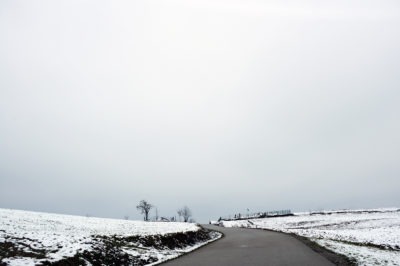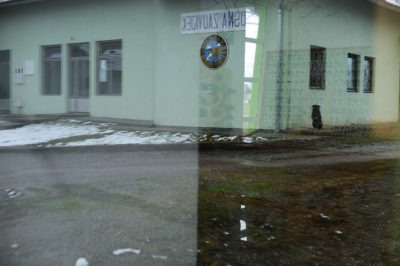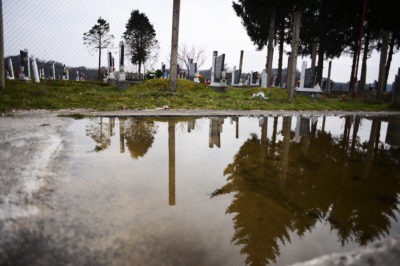I looked at all those dead faces, most of them I knew personally. Some were friends, some just acquaintances, but we had all shared moments of war together at some point. Our common memories from the past bind us wherever we may be today. Are they truly shahids, enjoying paradise now, or are they just underground, horizontal and mute.

If it were not for coincidence, you would never again see the places you forgot, repressed deep inside yourself, or places where you had never been. So it was for me. Working for CNA (Centre for Non-violent Action) in the Una-Sana Canton gave me an opportunity to visit the memorial room at Pištaline and the Ometaljka military cemetery. And also something I had never seen before: the phantasmagorical cemetery of Autonomous soldiers located in front and within the premises of the poultry plant near Velika Kladuša.
It was a hellishly cold day in Krajina when we ascended along the road through Ljusina to Pištaline, the road I could traverse with my eyes closed any time day or night. We pass the Šoferska noć bar where Alija Kurtović and me raced on crutches, both drunk, to see who would be first to reach the field hospital some hundred meters from the bar. And where the waitress, carrying a carton of beer cans, said to me, “May your mother carry you dead like this.” Only once had I been subject to a curse worse than that: in Skokovi, a place we had overtaken from the Autonomous forces, a girl said to me, “May your hair burn like this house.” It happened as we were walking past her house, while the house next door was burning as if doused in petrol.

We passed on through Pištaline and I remembered the improvised field hospital, and how I used a special wheelchair with a hole in the seat to go to the bathroom because my wound was fresh and I could not touch the ground with my left foot. I could, but this would cause unspeakable agony, bleeding and tears. So they came up with this wheelchair for us to use when we went to the outhouse, in April 1994, on some Krajina plain where the wind blew through our young bones. Then we reached the brigade command and entered the memorial room. Inside, it was cold like in a tomb. On the central wall were photographs of fallen fighters, some five hundred of them, with dates of birth and death. A literary critic and poetess from these parts would have been certain to use the phrase “violent death” instead. I’ve never heard a more stupid phrase. Can there be any other kind of death in war. As if death, no matter how much they insist on it being a natural phenomenon, is not an absolute form of violence against life.
I looked at all those dead faces, most of them I knew personally. Some were friends, some just acquaintances, but we had all shared moments of war together at some point. Our common memories from the past bind us wherever we may be today. Are they truly shahids, enjoying paradise now, or are they just underground, horizontal and mute. At the Ometaljka shahid / soldiers cemetery, it was even colder, the wind blowing down from the snowy hillocks took your breath away. I stood next to my friends and looked out at the white marble tombstones. At the end of the row of tombstones is a moss covered path. A few trees whose trunks are also covered in moss. I could imagine the lush green of the moss as a carpet upon which, at night, when there is no one around, the shadows of my dead comrades walk. I remember a funeral when twelve fighters killed in the liberation of Ćojluk were buried. I remember the late Ćipo and Šok. They seemed so alive that July (if my memory isn’t playing tricks on me) when they were buried. Ćipo had fresh cuts on his forehead, as if he had been walking through a thicket that had cut long red stripes across his face. Šok was lying on the tabut, serious as he had always been.
At the Ometaljka, apart from the wind, there were birds chirping excitedly, knowing it would soon snow, and that spring is unstoppable in its grace, reviving all living things with the fresh will to live. Later, we continued our journey looking for memorials to armies from the past war. We went through Skokovi, Pećigrad, where I explained to my fellow passengers where the so-called ruined house stills stands to this day and honours its name, for no one has tried to renew it yet. Shelled out holes are its futuristic windows. Just so there’s no misunderstanding, these are former battlegrounds with Fikret’s Autonomous forces, the peripheral villages of the Cazina Municipality facing Velika Kladuša. According to rough estimates, some 3500 were killed on both sides during the war. Many more members of the 5th Corps were killed here than fighting the VRS, popularly known around town as the Chetniks. So I really get a kick out of some Sarajevo imbecile asking me, “So, man, what happened, why did you all like slaughter each other?” Ask the late Alija Izetbegović, Tuđman and Milošević, let them tell you if the underground crows haven’t eaten their tongues by now.

The most interesting place we visited was definitely the Autonomous soldiers cemetery, very close to the town centre and the border with Croatia. The whole scene looks like it was lifted straight out of Andrei Tarkovsky’s Stalker. Muslim tombstones, and here and there a cross or two, right in front of the hangars where poultry used to be kept. The hangars have been plucked clean, looted, all that’s left are the ribs that used to support their roofs and wisps of glass wool that could not be looted. The place is surreally peaceful and deserted. The remains of industrial romanticism and a military cemetery on the premises of a former Agrokomerc factory. The evergreens growing among the graves. Birdsong and windmusic. Talking to Nijaz Miljković, wartime commander of the 506th Kladuša Brigade, who at my claim that there are hundreds buried here says, “Unfortunately, that’s true. There are both fathers and sons here, brothers, the destitute.” The way of the dead ends here. Inscribed on the monument to the fallen fighters of the Army of BiH that has been exiled to the yard of the town mosque are the verses of Skender Kulenović: “Dead eyes, but they see better down the field than the living. All bloodied from of old, now Krajina like a green dress…”
Faruk Šehić
the article was published in bh magazine “Dani” 12th of April 2013